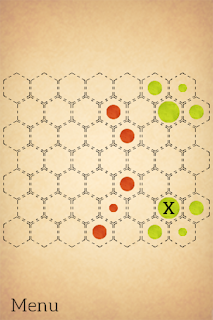It's not that they are difficult, but to play knowledgeably it's essential to have an exact understanding of the value of each piece on the board. The game however avoids showing clear numbers, relying only on the size of the pieces.
The play area is a board containing a few discs. You control the red ones; thre green ones are fixed in position. The goal is to surround the green pieces and turn them to your side.
The size of the piece indicates its value. The smallest ones are worth 1, the largest ones 3. To capture a piece you have to surround it with enough pieces to make a total value higher than the green's value, like this:
You don't see that here, but note that a red piece can attack multiple green pieces at the same time, without splitting its power.
The important rule to keep in mind while playing is that when a green piece turns to your side, it starts attacking the neighboring pieces as if it was a red piece. This can create long chain reactions. So look at this example:
Here the red pieces have a total value of just 2+2=4. The green pieces have a total value of 3+2+1=6, so it would seem impossible to win. But all you have to do is capture the largest green piece, which will turn your side and capture the piece to its right, which will in turn capture the piece to its right:
I think the most confusing thing is that when attacked, the green pieces reduce in size to indicate how far they are from being captured. This, however, means that you lose the indication of how much the piece will be worth to attack neighbors after turning to your side. It also means that the green pieces have an additional "extra small" size, which would effectively map to a value of 0, and indicates that the total value of the red pieces surrounding them is equal to the value of the piece.
The conquer rules make me think of wargames; this similarity is made even stronger by the puzzles played on a hexagonal board.
The X in this image is a special piece which will NOT attack its neighbors after being captured.
The user interface during the game is ok. I might have liked more feedback when you pick up a piece, for example it could grow in size as if you had lifted it from the board.
It would be nice if you could drop a piece on top of another to swap them, since this is something you often have to do while solving a puzzle. Currently, to swap A dn B you have to move A out of the way, put B where A was, and finally put A where B was. Three moves instead of one.
The game contains two packs of puzzles, one on square grids and another on hexagonal grids, for a total of 115 puzzles; 30 are free, an additional 85 can be unlocked with a single in-app purchase. The puzzles in each pack must be played strictly in sequence, which I found a bit annoying.
Once you have understood the rules, solving the puzzles doesn't seem to be much of a challenge: due to how the mechanics work, it clearly pays off to give precedence to attacking the pieces that are larger and have more neighbors, and to use cells that allow to attack multiple pieces at once. The solutions come naturally without even having to think much about the exact values of the pieces. Also, I noticed that many puzzles don't even require you to use all the available pieces.
If you are looking for a more casual puzzling experience, this might be the game for you. With some improvements here and there, it could become even better.
Summary
| Nontrivialness | ★★☆☆☆ |
| Logical Reasoning | ★★★★☆ |
| User Interface | ★★☆☆☆ |
| Presentation | ★★☆☆☆ |
| Loading Time | ★★★☆☆ |
| Saves Partial Progress | ✘ |
| Status Bar | ✘ |
©2013 Nicola Salmoria. Unauthorized use and/or duplication without express and written permission is strictly prohibited. Excerpts and links may be used, provided that full and clear credit is given to Nicola Salmoria and nontrivialgames.blogspot.com with appropriate and specific direction to the original content.






